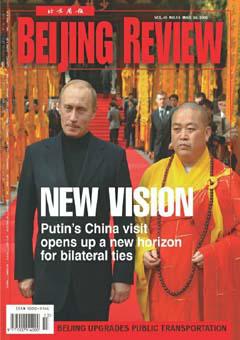Beijing by Bus
2006-12-11ZHANGZHIPING
ZHANG ZHIPING
Frequent traffic jams and worsening air quality are the bane of many Chinese cities. The problem is particularly pronounced in big and medium-sized ones. With rapid economic growth and a rise in living standards, more people are buying cars, leading to a worsening of the transportation woes in cities. Public transport, once the lifeline of city transportation, has fallen into neglect.
Some government organs, including the Ministry of Construction, have appealed to local governments to give priority to developing public transportation. At the end of 2005, Chinese Premier Wen Jiabao and Vice Premier Zeng Peiyan both joined the chorus. This gave new life to the slogan “public transportation first,” with Beijing taking the lead in implementing it ahead of the 2008 Olympic Games.
Beijing Mayor Wang Qishan predicted that in five years, the number of people using public transport in urban Beijing would account for 40 percent of the local population. This year, the Beijing Municipal Government will invest 5.4 billion yuan to beef up public transportation, roads in the vicinity of Olympic facilities and other civil engineering works--an 11.8 percent increase over 2005. By 2008, the number of buses reaching the Euro III auto emission standard will exceed 8,000 and more than 90 percent of the buses (of a total of 20,000) will use environment friendly fuels that will lead to a 76 percent drop in Beijings four major pollutants.
Studies worldwide show households can tolerate only a 10-12 percent share of total income for transportation and anything above that will prove burdensome. Low-income groups depend heavily on buses and will benefit particularly from cheap and reliable public transport. This will also help protect the environment and conserve resources. A large bus can take about 100 passengers at a time, while this same load will need about 30-50 cars. This number of cars would mean nine times more roads, five times more fuel and 15 times more emission of toxic gases.
There can be no doubt that developing public transportation is beneficial all-round. But for it to take off, policy-making alone is not enough. A mindset of “public transportation first” must be actively cultivated. Giving a boost to the public transit system must also reckon with other factors that go into a citys development such as public services, resource conservation and environmental protection. This will help the decision on whether it is worthwhile to invest limited capital resources in a system with low returns. Foreign cooperation, particularly with respect to managerial expertise and superior environmental protection technologies, should be encouraged.
A world-class city is defined not just by its physical beauty, modern office buildings or luxurious entertainment establishments, but also by a convenient transportation system. This is also crucial to building a harmonious society. Beijings move to develop more efficient public transportation has set a good example for the rest of the country.
